More dazzle, more dash in Milwaukee’s finest
High style meets high tech on the Tourers
Milwaukee, Wis., June 5–7—It’s the job of Harley-Davidson’s Custom Vehicle Operations division to question assumptions, think outside the box, and color outside the lines. They’re the mavericks of Milwaukee, the black ops boys of Parts and Accessories, the wild hair up the corporate keister, with but one overarching directive: Fulfill the vision of style guru and spiritual keeper of the Bar & Shield, Willie G. Davidson.
The division was created nearly a decade ago for the expressed purpose of targeting those corners of the American motorcycle market that the core OE lineup wasn’t adequately reaching; of designing and building what you might call niche-seeking missiles, and in so doing demonstrating just how far the Harley-Davidson brand can be stretched. In that regard, the division is not so much iconoclastic as iconelastic. Ouch. They enjoy an unusual degree of autonomy within The Motor Company, answering to few and pretty much setting their own agenda.
When you’ve got that kind of a mandate and that kind of latitude, nothing much is sacred—not even your own self-imposed rules, as we discovered with the unveiling of their 2008 Screamin’ Eagle models.
Not that the CVO ever had many rules, self-imposed or otherwise. Come to think of it, there were only two aside from the Willie G. vision thing, and they can be summarized thusly: 1) Thou shalt not customize the same specific model for more—or less—than two consecutive years. 2) Thou shalt turn your customizing attention to at least one new specific model annually. That’s how it’s worked, anyway, since 1999, with a model being retired after two customizing cycles and at least one new guinea pig being brought up for the CVO treatment, and this rotation was always staggered so that one was always going as one was coming. (The only exception to this protocol was the single-year appearance of the 2006 Screamin’ Eagle Destroyer, which as a competition-only tribute to the SE/VH NHRA successes of Andrew Hines, doesn’t really count.)
For 2008 even those marginal constraints have been jettisoned entirely, and the new lineup mirrors exactly the 2007 lineup. As a result, the FLHTCUSE Screamin’ Eagle Ultra Classic Electra Glide becomes the first model to appear in a third consecutive iteration, and for the first time in CVO history, no new blood has been brought into the aerie.
What does it all mean? Not much, really, except the abstract possibility that the CVO has matured to the point that they’re less a skunk works and more a production-custom establishment in the Milwaukee scheme of things. And, in practice, it means even less since the returning models—the creamin’ Eagle Ultra Classic, Road King, Dyna and Softail Springer—are returnees in name only. Cosmetically and functionally, all four models received extensive revisions, some of them quite dramatic, as we’ll see.
But before breaking it down by cases, we should point out the principle custom attribute they all share in common, and that’s the TC110 motor. This mill debuted exclusively on the 2007 CVO bikes as the largest displacement factory motor ever, and included a number of enhancements to the TC96 from which it was derived. Among those enhancements were the larger displacement, achieved by widening the bore to 4.00 inches, forged pistons, enlarged intake valves, high-flow ports, higher compression coupled with automatic compression releases to expedite start-ups, and cam profiles designed to extract maximum torque from the motor. The thing is a torque monster, dishing up 115 ft/lbs at 3,000 rpm on the Tourers, 105 ft/lbs on the Dyna and 110 ft/lbs on the Softail Springer. That motor returns unchanged internally for 2008, but now has a new “Granite” powder coat finish on the cases that incorporates stainless steel flakes into the recipe, giving the motor a rich, nearly opalescent patina.
The other notable feature they all share is the availability of 105th Anniversary graphic and accessory packages. These specimens will be limited in number and are distinguished by a Crystal Copper and Black Onyx paint scheme with graphic elements executed in gold leaf, a commemorative cloisonné medallion, and a Smart Siren security system. Additionally, the owner gets a goodie bag containing a gold key and a storage cover, and it all goes for the low, low price of $495.
Dyna do-over
The Screamin’ Eagle Dyna introduced last year was a real head-turner with its inverted front fork suspension and aggressive pro-street styling, but it received, shall we say, mixed reviews when it came to handling and ergonomics. So given the opportunity to have another go at it, the CVO Dyna team, led by Greg Falkner, revisited the front end geometry and operator positioning and improved things significantly. The front fork was slammed an inch, and the rake was drawn in 3.5 degrees to 29 degrees. The seat was redesigned to put the rider closer to the foot controls and handlebars, and the handlebars were pulled back slightly as well. The result is excellent operator comfort and control, and quick confident handling in the curves. Other changes brought to the new Dyna include covered rear shock absorbers and a new chrome tank console. The new console incorporates the ignition switch, relocated from its previous position on the frame neck, and a four-inch speedometer, relocated from the handlebars. In its place on the bars, the Dyna now has a four-inch tachometer. The tank has been given a flush-mount fuel cap with LED fuel level indicators. The Slotted 6-Spoke wheels on the bike are a popular P&A catalogue product, but in this application they’ve been hand-polished on all surfaces for an extreme dazzle factor. Price of the FXDSE2 is $24,995 without the anniversary package.
Springer on the catwalk
While the Softail Springer was removed from the OE stable last year, it continues to thrive in the CVO lineup under the supervision of team manager Jeff Smith, and this year received an impressive infusion of custom styling and engineering elements. Up front the skinny 21-inch wheel has been replaced with some serious meat—an 18-inch 130mm radial, to be exact. It also got a new fender and fender strut, and the brake was moved to the left side of the axle to clean up the view on the pipe side. Also improving the view on that side of the bike—and simultaneously improving performance—is a Heavy Breather air intake. This intake is actually an existing race-only item from the P&A catalog that the CVO reworked into street-legal trim, and they did so without sacrificing its hot rod induction characteristics. As a result, the Springer’s TC110B motor gets a 5 percent bump in torque over last year’s motor, giving it 110 ft/lbs. The forward-facing nose of the Heavy Breather also gets a bold “110 c.i.” escutcheon to announce its presence with authority.
The striking cosmetic treatment on the new Springer involves what Jeff Smith calls “extreme color matching,” that gives the tank, fenders, headlamp shell, frame, swingarm, oil tank and front fork the same color treatment. But what’s more, the fenders and headlamp shell also carry the tank’s second color and graphic design, and that design has a unique detail in the form of a flame-grind bare metal pattern under an accent candy coat. The basic technique used here debuted on the 2006 Screamin’ Eagle Fat Boy, but it’s been taken a step further on the new Springer with the swirl pattern being replaced by grind marks that look like flames. The visual effect is eye-popping, especially in direct sunlight, and the technique is a closely guarded secret. The FXSTSSE2 sells for $24,995.
High-tech touring
The remaining two CVO models for 2008 are both Tourers: the Screamin’ Eagle Road King and Ultra Classic Electra Glide, and before ticking off the superficial changes brought to the individual models, we need to start with a look at the momentous upgrades they’ve both received this year. The most momentous is the fitting of an anti-lock brake system (ABS) to the bikes. The use of an ABS is not new to Harley-Davidson, having been offered previously on their police models, but the system used on the CVOs is a whole different animal—and a largely invisible animal at that. That invisibility was the prime objective of Harley-Davidson in designing this ABS, and its development and application were basically a game of “hide the ABS” that started at the wheels. To hide the sensor components and keep the axles visually uncluttered, the engineers devised a magnetic encoder that’s actually contained in the wheel bearing, and a decoder that’s part of the axle spacer. The only telltale that’s there an ABS on the bikes is a single inconspicuous wire emanating from the axle. With that detail out of the way, the next challenge was to find a location for the ABS module less invasive than stashing it in a saddlebag, as is the case on the police units. And this is where the dominoes start to fall. Stay with me.
In surveying the situation, the engineers deemed that the most desirable and unobtrusive location for the module would be in the compartment behind the right-side cover. The only problem with that approach was that that real estate was already spoken for by the cruise control module on the Tourers so equipped. Bummer.
But if you think a little detail like that is going to discourage an engineer, you know nothing of engineers. To overcome that obstacle, the designers decided that the cruise control module would have to be eliminated, and the only way to do that was to make the thing a peripheral circuit of the fuel injection control unit. And all they had to do to effect that change was to eliminate the throttle cable.
Say what?
You heard me. The new Tourers have replaced the throttle cable with a wire; a wire that’s part of an electronic throttle control (ETC). It’s not a new technology. It’s been in use in the automotive industry for years and is referred to more colloquially as “fly-by-wire.” It is, however, a dramatic break with the past on a motorcycle. With this setup, the twist grip no longer pulls a cable through a sheath, mechanically actuating the throttle plate on the throttle body. Instead, the twist grip acts as a rheostat dial and talks directly to the fuel injection system’s brain, telling it what the operator demands. The ECU takes it from there, factoring that demand into the performance formula and then telling the throttle plate how to behave accordingly. It’s an elegant solution and an elegant setup, and not only does it eliminate the maintenance, adjustment, and operational vagaries of a mechanical throttle, it optimizes motor performance and provides an unprecedented smoothness in throttle operation and response.
That smoothness is further enhanced on the bikes by yet another feature brought to the Tourers this year called the Isolation Drive System, which in essence is a rear wheel compensator. It’s a borrowed technology from the V-Rod platform that functions to take up the whip and lash of the final drive under abrupt on-throttle and off-throttle antics (which is something the V-Rods know a thing or two about).
Two more upgrades of note have been made to the 2008 Tourers, the first being the use of industry-leading Brembo brake components, and the second being the replacement of the five-gallon fuel tank with a six-gallon unit, thus giving the bikes a dependable 200-mile range before that pesky low-fuel warning light flickers on.
Tourer particulars
Besides all of the foregoing upgrades, the 2008 Screamin’ Eagle Road King, remodeled under the direction of team manager Phil Zagrodnik, returns to the lineup virtually unchanged, with the welcome exception of a full FL-style front fender in place of the Fat Boy-derived fender of 2007, and the relocation of the idiot lights to a new panel on the handlebar riser. This model runs $29,290. The 2008 Ultra Classic, with Randy Riley as the team leader, gets a little more thorough going over. The new model trades in the leather-covered top box of yesteryear for a conventional King-sized Tour-Pak, only this OE item gets some additional cosmetic attention as befits a Screamin’ Eagle. Specifically, the panel that encases the wrap-around lights has been color-matched to the rest of the bike. Also in the area of touring bodywork, the wind deflectors on the lower corners of the batwing are now adjustable, and can be folded back in hot riding conditions to increase air flow in the cockpit. The electronic luggage-locking capability introduced last year, and actuated by a switch on the dashboard, has been taken to the next level and can now be triggered by a button on the key fob. At $34,995, the FLHTCUSE3 is the top of the line.
Taking it to the street
When the test-riding portion of the press launch program came on our second day in Milwaukee, the greatest interest for all was, naturally, the performance and ride quality characteristics of the ABS and ETC on the Road King and Ultra Classic. And in anticipation of that interest, the CVO crew staged a really kinetic demonstration of the system’s abilities. They staged it on a gravel-strewn straightaway on the grounds of the Pilgrim Road Powertrain facility, and pressed into service a guy named Bjorn Christensen, who must have a very interesting job description, indeed. His job that day was to flog an outrigger-equipped Ultra Classic back and forth on the straightaway, slamming on the brakes. He’d take one pass with the ABS turned off, and then one with the system in play. What a maniac. And what a difference, as you can tell from the photos below.
Since I didn’t have the benefit of outriggers on the Ultra Classic I took out on the highway that day, I wasn’t quite as cavalier about the ABS as Bjorn had been—at least not at first. Under most riding conditions, you’re not even aware that there’s an ABS on the machine, and nothing about your braking technique changes at all, nor should it. It’s only when you positively jam on the brakes that the system kicks in. The reaction of the system as experienced by the operator is described by Harley-Davidson as a “pulse” in the lever and pedal, but that’s not the best term to describe what happens. It’s more of a “whack” against your boot or glove, and the first time it happens it’s totally weird. The second time it happens it’s only kinda weird. By the third time you jam on the binders, it’s familiar enough to start experimenting with. Especially the rear brake, which when you stomp on the pedal delivers a rapid-fire double-chirp off the tire and a completely controlled and linear stop. It becomes habit forming. It would be irresponsible for me to characterize that behavior as “fun,” and obviously it’s a bad habit to get into, especially when you then get on a bike not equipped with ABS and overlook that minor detail. And in no extreme should the ABS ever be considered an alternative to practiced, prudent brake operation. It’s only there for panic stops, period. But it sure is fun.
The electronic throttle control on the Tourers is an absolute delight. For one thing, it gives the twist grip an ease of operation that’s almost eerie, owing to the fact that the only resistance to your wrist is the spring tension within the grip itself, and there’s just enough of it to return the throttle to its stop when released. There’s none of the mechanical drag and lag time associated with pulling a cable. Throttle response is instantaneous and spooky smooth. That smoothness extends also to the power transmission to the rear wheel, both as a function of the ECU’s direct involvement in throttle control, and of the Isolation Drive System. There’s no jerkiness or shudder of any kind at any time, and while it’s impossible to apportion credit for that phenomenon between the ETC and IDS, between the two of them you get the most seamless, predictable, and gratifying performance manners of any Milwaukee machine to date.
The future’s in the bag
Baggers have become the hottest segment of the domestic motorcycle market—the only segment of the market with any heat at all, lately—and the OE manufacturers and production custom producers have been busy positioning themselves to exploit that trend. It’s a trend unlikely to wane anytime soon, considering that consumer demographics continue stubbornly to age with little indication of a young-blood infusion in the statistics. That explains a number of things, here. It explains why the Ultra Classic remains in the Screamin’ Eagle collection for a third year (and don’t bet against a fourth, now that the rule’s been broken). It explains why, for 2008, the limited production quotas for the Tourers are significantly higher than for the others. Most voluminous will be the Ultra Classic at 4,200 units, the Road King follows with 3,150, the Dyna output will be 2,600 and the Softail Springer limited to 2,500. It also explains why the Tourers received the extensive special treatment they did this year. And lastly, and most significantly, it explains why all of the prominent functional improvements brought to the Screamin’ Eagle Tourers—the ETC, Brembo brakes, Isolation Drive, six-gallon tank, and ABS—will also be applied across the whole Harley-Davidson OE Tourer platform for 2008 (with the ABS as a $795 option).
It’s shaping up to be a great year for bagger pilots.



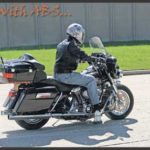

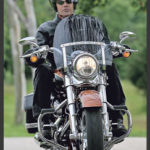
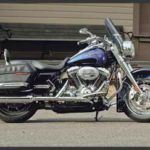
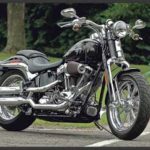



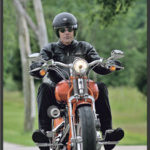

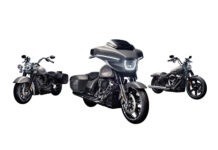
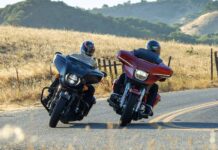
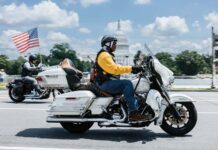

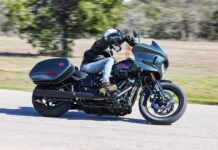










Does the 2008 CVO springer have electronic throttle!
Cheers
Guy
The TC 110B for 2008 has ESPFI as standard equipment.